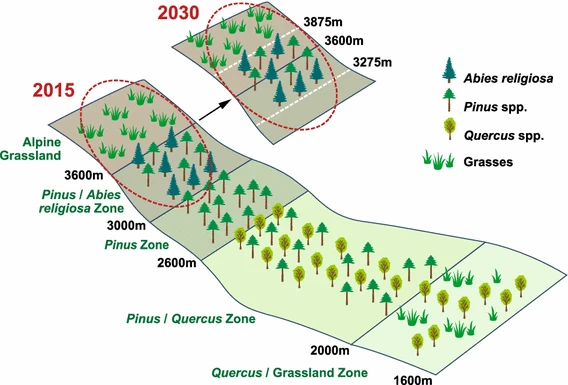Temperate Forest Restoration
Temperate forest restoration involves reforesting and rehabilitating temperate forests to enhance carbon sequestration, improve biodiversity, and mitigate climate change. This approach aims to restore ecological balance and provide long-term environmental benefits.

Assisted migration of Abies religiosa 275 m upwards in altitude to mitigate changes in climate (Springer)
View open jobs in this Solution
Example Organizations
- The Nature Conservancy - Works on reforestation projects globally.
- World Wildlife Fund (WWF) - Promotes forest conservation and restoration.
- Forest Stewardship Council (FSC) - Sets standards for responsible forest management.
Overview
There has been significant progress made in developing temperate forest restoration to reverse climate change. Breakthrough technologies that have been developed include:
- Carbon Dioxide Removal: Captures and stores CO2 from the atmosphere.
- Reforestation: Planting trees in deforested areas to restore forests and their carbon storage capacity.
- Soil Carbon Sequestration: Sequestering carbon in the soil to prevent it from entering the atmosphere.
Companies and organizations at the forefront of this solution include Carbon Engineering, The Nature Conservancy, and The Climate Group.
Progress Made
Significant advancements have been made in temperate forest restoration:
- Reforestation: Planting trees in deforested areas to restore ecosystems.
- Afforestation: Establishing forests in areas where there were none before.
- Assisted Natural Regeneration: Facilitating the natural regrowth of forests.
Solutions by Sector
Carbon Sequestration
- Carbon Dioxide Removal: Technologies to capture and store CO2 from the atmosphere.
- Biochar: Using biochar to sequester carbon in the soil.
- Agroforestry: Integrating trees into agricultural systems to enhance carbon storage.
Case Studies:
- Carbon Engineering, Canada: Develops direct air capture technology to remove CO2 from the atmosphere (Carbon Engineering). While promising, the technology is still in the early stages of commercialization.
- Biochar in the Pacific Northwest, USA: Biochar application in forest restoration projects has improved soil health and sequestered carbon (USDA Forest Service).
- Agroforestry in France: Integrating trees into agricultural landscapes has enhanced carbon sequestration and biodiversity (Agroforestry Research Trust).
Reforestation and Afforestation
- Reforestation Projects: Planting trees in deforested areas to restore ecosystems.
- Afforestation Initiatives: Establishing forests in areas where there were none before.
- Community-Based Forestry: Engaging local communities in forest restoration efforts.
Case Studies:
- The Nature Conservancy, Global: Reforestation projects in the United States, Brazil, and China have restored millions of hectares of forest (The Nature Conservancy).
- Green Belt Movement, Kenya: Community-based reforestation efforts have planted over 51 million trees (Green Belt Movement).
- Eden Reforestation Projects, Global: Reforestation initiatives in Madagascar, Nepal, and Haiti have restored degraded lands and improved livelihoods (Eden Reforestation Projects).
Ecosystem Restoration
- Assisted Natural Regeneration: Facilitating the natural regrowth of forests.
- Invasive Species Management: Removing invasive species to allow native forests to recover.
- Habitat Restoration: Restoring habitats for wildlife and enhancing biodiversity.
Case Studies:
- Kibale Forest National Park, Uganda: Successful restoration of degraded forest areas has improved biodiversity and ecosystem services (Kibale Forest).
- Appalachian Regional Reforestation Initiative, USA: Restoring native forests on former mining lands has improved water quality and wildlife habitat (ARRI).
- Great Green Wall, Africa: Large-scale reforestation and land restoration initiative across the Sahel region to combat desertification and improve livelihoods (Great Green Wall).
Lessons Learned
- Clear Planning: A clear and concise plan with specific goals and objectives is crucial for large-scale forest restoration projects.
- Stakeholder Engagement: Consulting with local communities and stakeholders ensures buy-in and support for restoration efforts.
- Funding Challenges: Securing funding for long-term forest restoration projects can be difficult.
- Coordination: Coordinating efforts across large geographical areas and multiple organizations is challenging but necessary for success.
Challenges Ahead
- High Costs: The high cost of forest restoration is a significant barrier.
- Land Availability: Large tracts of land are needed for effective restoration.
- Public Awareness: Increasing public awareness of the benefits of forest restoration is crucial.
- Political Support: Gaining political support for forest restoration initiatives is essential.
- Financial Support: Securing financial backing for long-term projects is challenging.
Best Path Forward
- Reforestation and Afforestation: Continue to promote and implement reforestation and afforestation projects.
- Community Engagement: Engage local communities in forest restoration efforts.
- Policy Support: Advocate for policies that support forest restoration.
- Funding and Incentives: Develop funding mechanisms and incentives to support restoration projects.
- Research and Development: Invest in R&D to improve restoration techniques and outcomes.
Prominent supporters include The Nature Conservancy, World Wildlife Fund, and Forest Stewardship Council.
Image credit: Springer